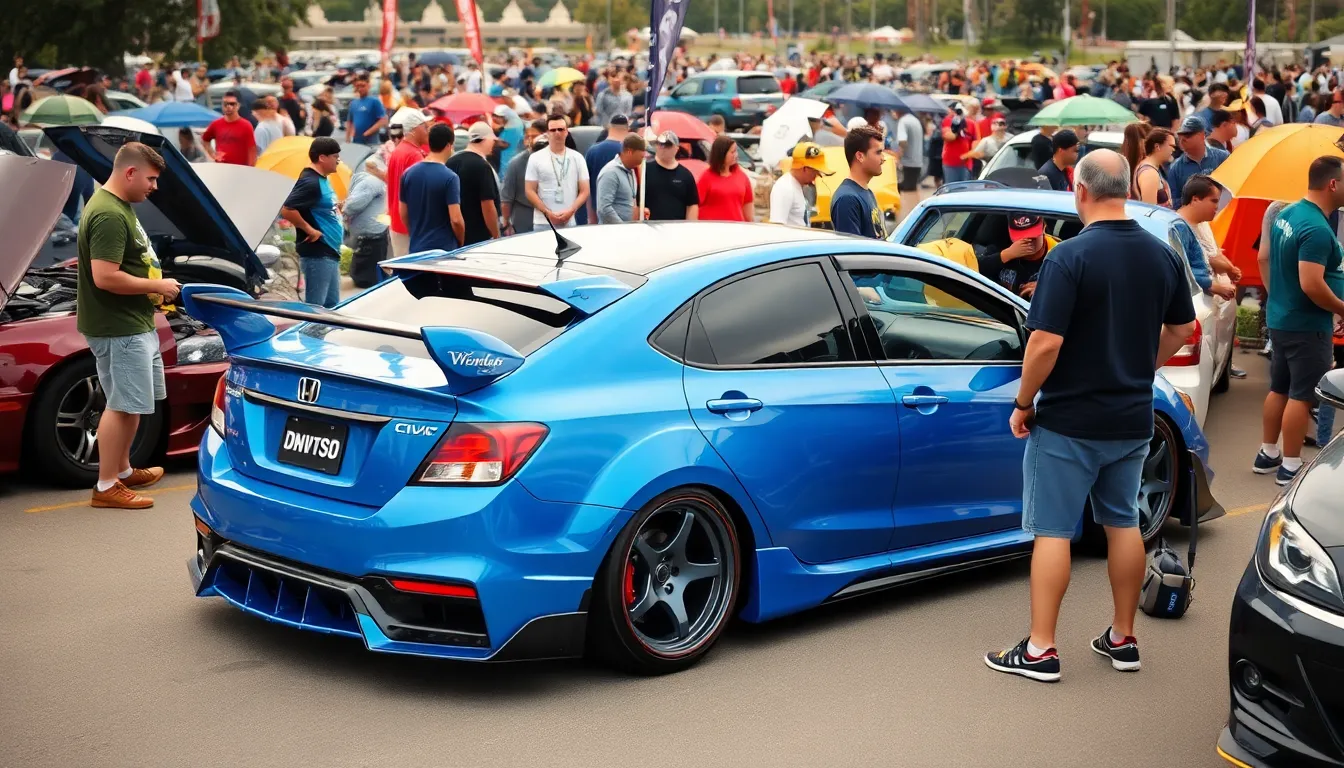Modified cars represent one of the most exciting ways we can transform our vehicles from basic transportation into personalized masterpieces. Whether we’re talking about performance upgrades that boost horsepower or aesthetic modifications that turn heads on the street, car modifications allow us to express our unique style and driving preferences.
The industry of automotive customization has exploded in recent years with endless possibilities for enhancement. From turbochargers and cold air intakes to custom body kits and LED lighting systems, we’ve got more options than ever to make our rides truly our own. These modifications aren’t just about looks – they can dramatically improve performance, handling, and overall driving experience.
We’ll explore everything you need to know about modified cars, from popular modification types to legal considerations and cost factors. Whether you’re a seasoned gearhead or just starting your modification journey, understanding the ins and outs of car customization will help you make informed decisions about transforming your vehicle.
Top 10 Most Popular Modified Cars Among Enthusiasts
We’ve identified the most sought after vehicles in the modification community based on their tuning potential and enthusiast appeal. These cars consistently dominate forums, car shows, and racing circuits worldwide.
Honda Civic
Honda Civic models remain the ultimate canvas for first time modifiers and seasoned enthusiasts alike. We see countless Si, Type R, and standard Civic variants transformed with cold air intakes, coilover suspension systems, and turbocharger upgrades. Popular modifications include K20 and K24 engine swaps that can produce 300+ horsepower, aggressive body kits from brands like Mugen and Spoon Sports, and lightweight racing wheels such as Enkei RPF1s.
Performance enthusiasts often target the suspension geometry first with adjustable coilovers from KW or BC Racing. Aesthetic modifications typically feature lowered stance configurations, aftermarket exhaust systems like Invidia or Skunk2, and custom paint schemes ranging from JDM inspired liveries to modern matte finishes. Interior upgrades commonly include Recaro bucket seats, short throw shifters, and digital gauge clusters.
Subaru WRX STI
Subaru WRX STI models dominate rally inspired modification scenes with their all wheel drive capabilities and turbocharged engines. We observe owners frequently installing larger turbochargers, upgraded intercoolers, and performance engine management systems that push power outputs beyond 400 horsepower. Common exterior modifications include aggressive front splitters, carbon fiber hoods, and rally style mud flaps from companies like RokBlokz.
Engine bay modifications typically focus on the EJ257 powerplant with upgraded fuel injectors, high flow fuel pumps, and performance air intake systems. Suspension setups often feature rally exact coilover systems, strut tower braces, and sway bar upgrades that improve cornering performance on both street and track. Popular wheel choices include Method Racing wheels paired with aggressive tire compounds for maximum grip.
Mazda MX-5 Miata
Mazda MX-5 Miata generations consistently attract track focused enthusiasts who prioritize handling over straight line speed. We find owners commonly installing roll bars, racing seats, and stripped interior configurations that reduce overall weight by 200+ pounds. Performance modifications typically include turbocharger kits from companies like Flyin’ Miata, upgraded brake systems with larger rotors, and limited slip differentials.
Suspension modifications represent the most popular upgrade path with coilover systems from Ohlins, Bilstein, and Tein leading the market. Aesthetic changes often emphasize functional aerodynamics through front air dams, rear spoilers, and side skirts that improve airflow. Engine swaps featuring Ford Coyote V8s or Honda K series motors create unique high performance builds that maintain the car’s lightweight characteristics.
Essential Performance Modifications Every Car Owner Should Consider
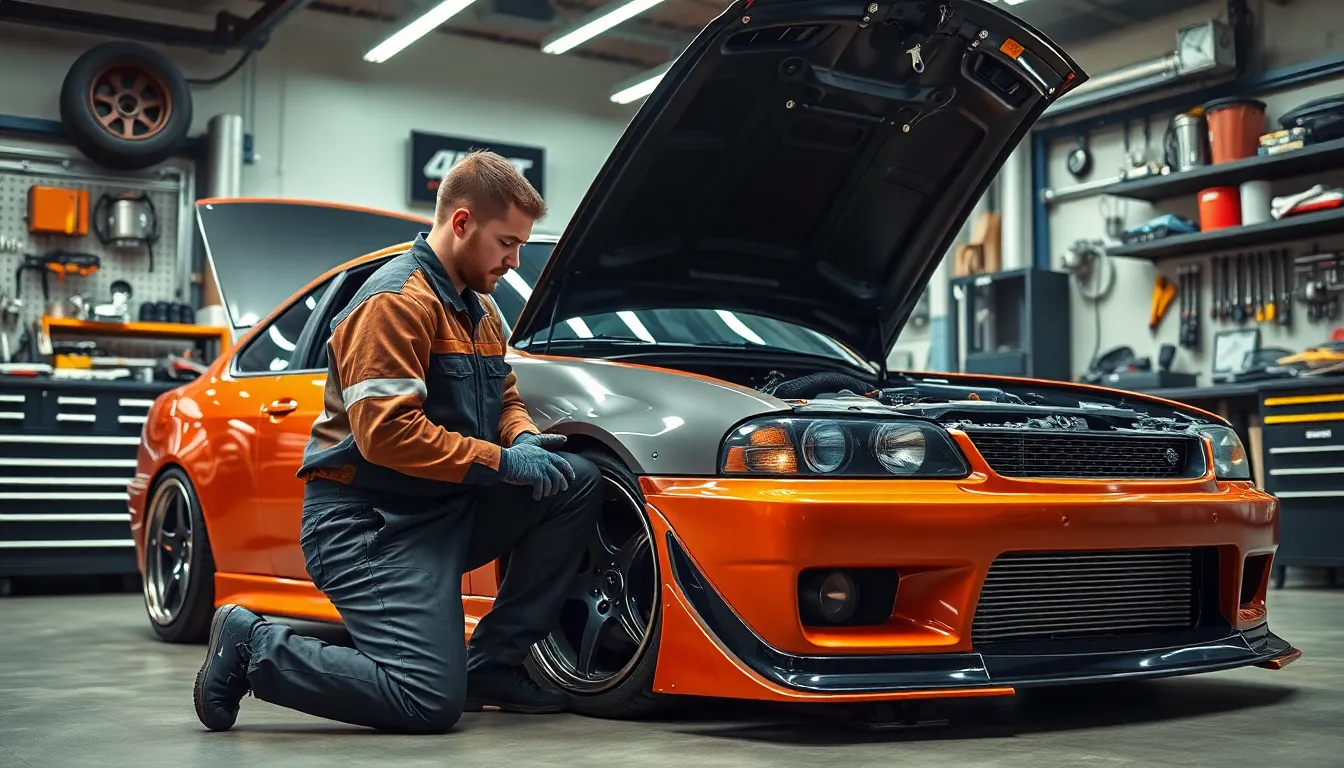
Performance modifications unlock your vehicle’s true potential and deliver noticeable improvements in power delivery and driving dynamics. We’ll explore three fundamental upgrades that provide excellent value for both beginners and experienced enthusiasts.
Engine Tuning and ECU Remapping
Engine tuning optimizes your vehicle’s computer system to extract maximum horsepower and torque from existing components. We recommend ECU remapping as the most cost-effective performance modification, typically adding 15-30% more power for $500-$1,500.
Professional tuning shops reprogram your engine control unit to improve fuel maps, ignition timing, and boost pressure on turbocharged engines. Stage 1 tunes work with stock components and deliver immediate results, while Stage 2 modifications require supporting modifications like upgraded fuel systems.
Custom dyno tuning provides the best results compared to off-the-shelf maps, ensuring your exact engine receives personalized optimization. We suggest finding certified tuners who specialize in your vehicle make and model for optimal results.
Cold Air Intake Systems
Cold air intake systems replace restrictive factory air boxes with high-flow filters and larger diameter piping to increase airflow to your engine. We’ve observed power gains of 5-15 horsepower from quality intake systems, along with improved throttle response and enhanced engine sound.
Short ram intakes mount directly in the engine bay and cost $150-$400, making them popular choices for street-driven vehicles. Long tube cold air intakes extend into cooler areas of the vehicle and provide better performance gains but require more installation time.
Maintenance involves cleaning reusable filters every 10,000-15,000 miles using specialized cleaning kits. We recommend brands like K&N, AEM, and Injen for their proven track records and comprehensive warranty coverage.
Exhaust System Upgrades
Exhaust system modifications reduce backpressure and allow engines to breathe more efficiently while creating distinctive sounds that enhance the driving experience. We typically see power gains of 10-25 horsepower from complete cat-back exhaust systems, which replace components from the catalytic converter to the tailpipe.
Performance headers replace restrictive factory manifolds and provide the greatest power improvements, especially when combined with high-flow catalytic converters. Axle-back systems offer a more affordable option at $300-$800 and primarily change exhaust tone without important power gains.
Material choices include stainless steel for durability and titanium for weight reduction, though titanium systems cost significantly more. We advise checking local noise regulations before installing aggressive exhaust systems, as some areas have strict sound level limits for modified vehicles.
Visual Modifications That Transform Your Car’s Appearance
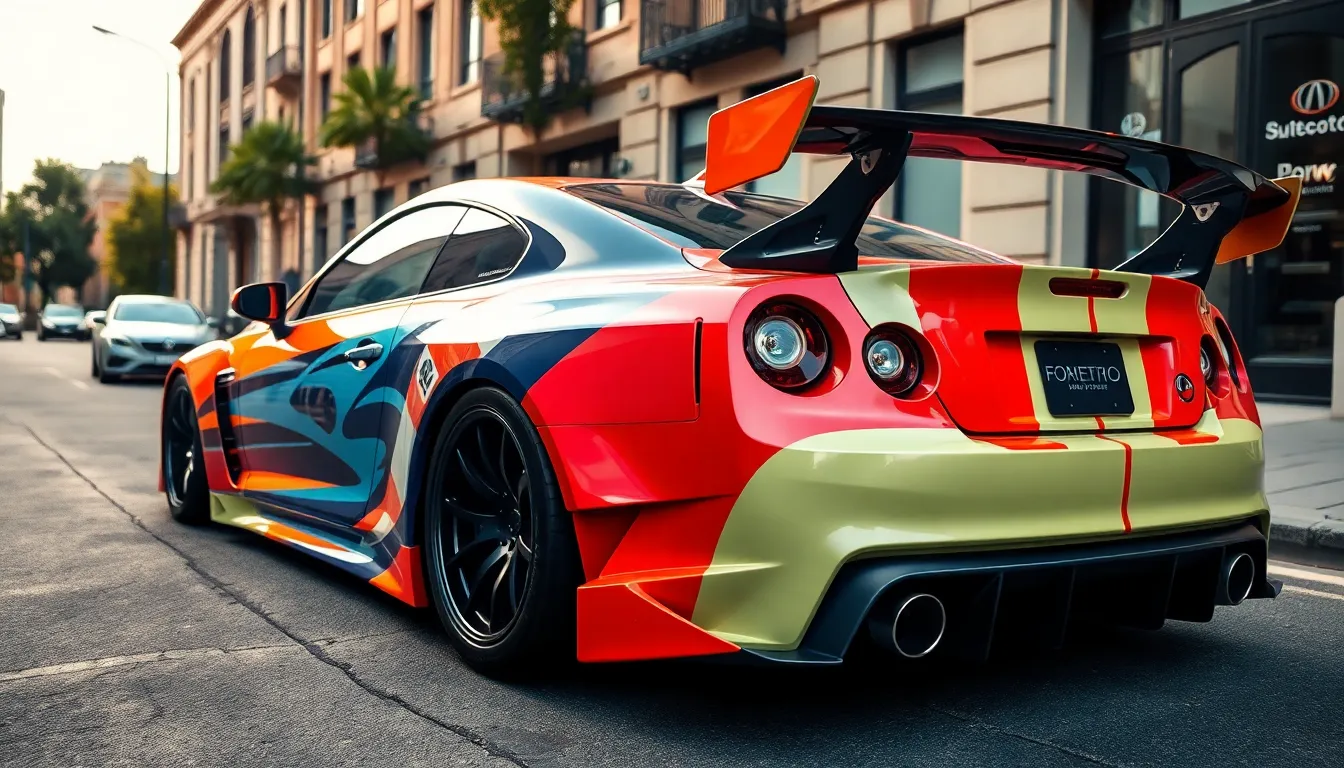
Beyond performance upgrades, visual modifications create the most dramatic transformations that instantly set your modified car apart from factory models.
Body Kits and Aerodynamic Enhancements
Body kits completely reshape your vehicle’s profile while improving aerodynamic efficiency. Wide body kits like Liberty Walk or Rocket Bunny designs add aggressive fender flares that accommodate wider wheels and tires. Front splitters reduce air pressure under the vehicle, creating downforce that improves high-speed stability.
Side skirts create a seamless connection between front and rear elements while reducing turbulent airflow along the car’s sides. Rear diffusers channel airflow smoothly from underneath the vehicle, reducing drag and adding a race-inspired appearance. Carbon fiber materials offer the perfect balance of lightweight construction and premium aesthetics.
Spoilers and wings serve dual purposes by improving both form and function. Fixed rear wings generate measurable downforce at highway speeds, while adjustable units allow fine-tuning for different driving conditions. Popular options include ducktail spoilers for subtle enhancement or large GT wings for maximum visual impact.
Custom Paint Jobs and Vinyl Wraps
Custom paint work transforms your car into a truly unique masterpiece that reflects your personal style. Multi-stage paint systems with metallic flakes, pearls, or color-changing pigments create depth and visual interest under different lighting conditions. Matte finishes provide a sophisticated, understated appearance that’s become increasingly popular among enthusiasts.
Vinyl wraps offer unlimited design possibilities without permanent alterations to your original paint. Full vehicle wraps in satin, gloss, or textured finishes protect the underlying paint while allowing complete color changes. Chrome delete packages using black vinyl eliminate factory chrome accents for a more modern, cohesive appearance.
Accent graphics add personality through racing stripes, geometric patterns, or custom artwork that highlights your car’s best features. Reflective or luminescent materials create stunning effects during nighttime driving. Professional installation ensures proper adhesion and prevents bubbling or peeling over time.
Wheel and Tire Upgrades
Aftermarket wheels instantly modernize your vehicle’s appearance while reducing unsprung weight for improved performance. Forged aluminum construction offers the best strength-to-weight ratio, with popular brands like BBS, Volk Racing, and Enkei leading the market. Wheel sizes typically range from 17 to 20 inches for street applications.
Tire selection dramatically affects both aesthetics and driving dynamics. Performance tires with wider contact patches improve grip while creating a more aggressive stance. Low-profile sidewalls enhance steering response and give wheels a larger visual presence. Specialized compounds for track, street, or all-season use ensure optimal performance in different conditions.
Fitment considerations determine the final stance and appearance of your modified car. Proper offset calculations ensure wheels sit flush with fender lips without causing clearance issues. Stretched tire setups create clean wheel-to-fender gaps, while meaty sidewalls provide a more muscular appearance and better pothole protection.
Interior Modifications for Enhanced Comfort and Style
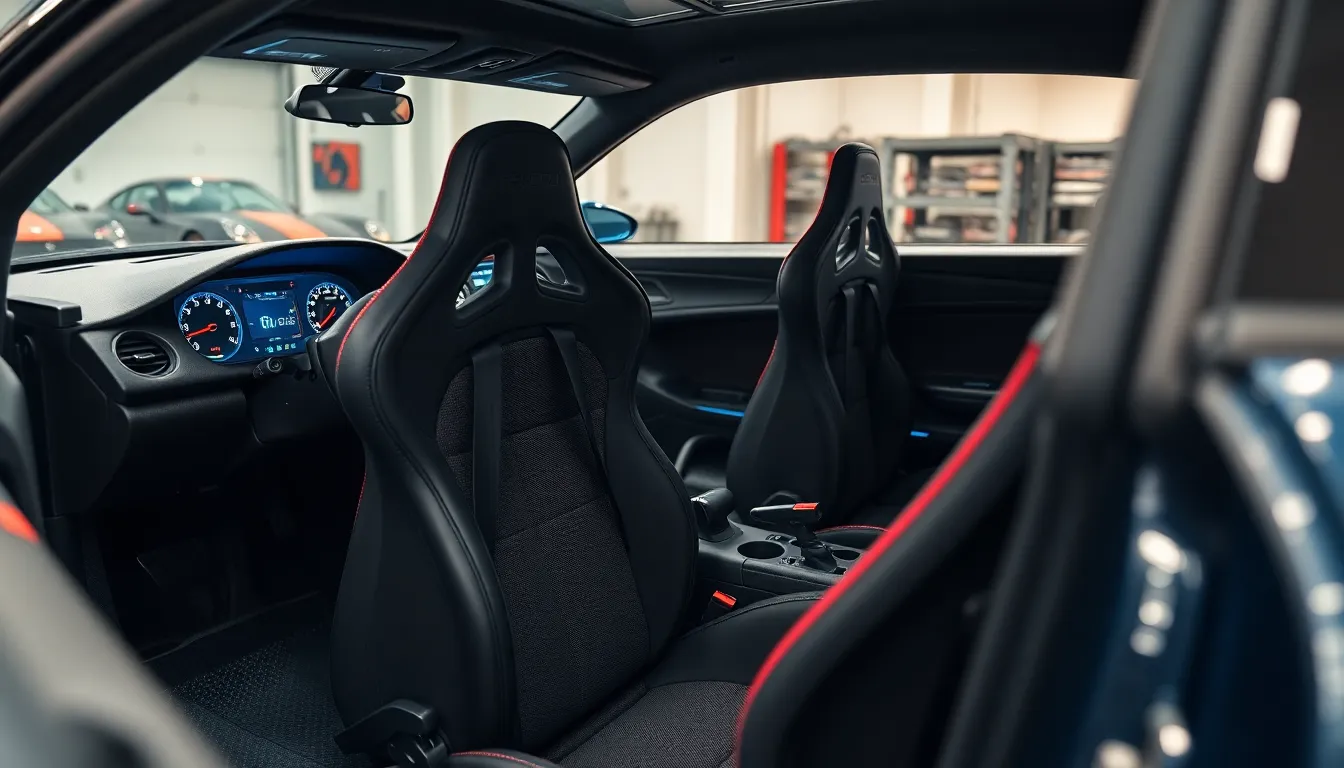
Interior modifications create the perfect environment where drivers connect with their vehicles on a daily basis. We’ll explore how strategic interior upgrades transform mundane cabins into personalized command centers that enhance both driving pleasure and vehicle value.
Racing Seats and Harnesses
Racing seats deliver superior lateral support that keeps drivers firmly planted during aggressive cornering and high performance driving sessions. Bucket seats from manufacturers like Recaro, Sparco, and Bride feature lightweight construction with deep side bolsters that eliminate sliding during track days. Fixed back racing seats reduce weight by 15-20 pounds compared to factory seats while providing improved pedal feel through enhanced driving position.
Four point and six point racing harnesses distribute crash forces across the chest and shoulders more effectively than standard three point seatbelts. Harness systems require proper mounting points and roll cage integration to meet safety standards set by organizations like the SFI Foundation. Track focused builds often incorporate quick release mechanisms that allow rapid driver egress during emergency situations.
Reclining sport seats offer a compromise between daily comfort and performance support for street driven modified cars. Brands like Corbeau and OMP manufacture DOT approved racing seats that maintain factory safety features while delivering enhanced comfort during spirited driving. Semi bucket designs accommodate drivers of various sizes while preserving side impact protection required for street legal vehicles.
Custom Dashboard and Gauge Clusters
Digital gauge clusters replace analog instruments with customizable displays that monitor multiple engine parameters simultaneously. Systems from AEM Electronics and Haltech provide real time data for boost pressure, air fuel ratios, and exhaust gas temperatures that help drivers optimize performance. Programmable warning lights alert operators when critical thresholds are exceeded during high performance driving.
Custom dashboard fabrication allows complete interior personalization using materials like carbon fiber, aluminum, and leather wrapped surfaces. Fiberglass dash modifications accommodate aftermarket gauge pods while maintaining factory ergonomics and climate control functionality. Professional upholstery shops create seamless integration between stock components and custom elements for show quality finishes.
Auxiliary gauge pods house additional monitoring equipment without compromising dashboard aesthetics or functionality. Triple gauge pillars mount boost gauges, oil pressure monitors, and temperature sensors in easily visible locations. Center console gauge clusters display transmission temperatures and fuel pressure readings that help drivers maintain optimal engine performance during extended track sessions.
Sound System Upgrades
Component speaker systems dramatically improve audio clarity through dedicated tweeters, midrange drivers, and subwoofers designed for exact frequency ranges. Alpine, Focal, and JL Audio manufacture speakers that handle increased power while delivering audiophile quality sound reproduction. Custom speaker enclosures optimize acoustic performance by matching driver specifications to interior cabin volumes.
Amplifier upgrades provide clean power delivery that eliminates distortion at high volume levels while improving ever-changing range across all frequencies. Class D amplifiers offer compact installations that preserve trunk space while delivering substantial power output for demanding speaker loads. Multi channel amplifiers support component systems with dedicated channels for subwoofers and full range speakers.
Sound deadening materials reduce road noise and vibrations that interfere with audio quality in modified vehicles. Products like Dynamat and SecondSkin dampen panel resonance while improving overall cabin acoustics. Strategic placement behind door panels and floor sections creates quieter environments that allow subtle audio details to emerge during listening sessions.
Safety Modifications That Protect Modified Cars
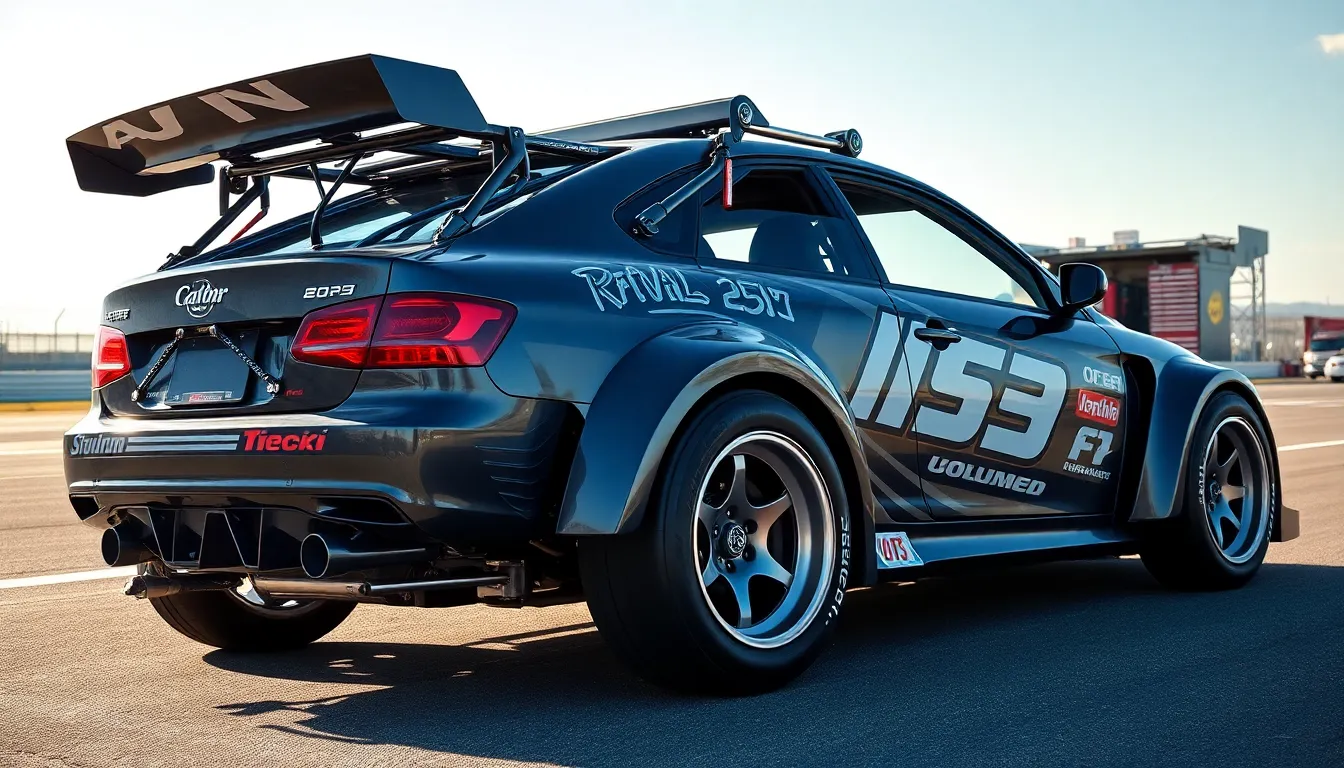
When we push our modified cars to their performance limits, we need protective measures that match our enhanced capabilities. Safety modifications transform potential risks into manageable scenarios while preserving the driving experience we’ve worked so hard to achieve.
Roll Cages and Safety Bars
Full roll cages provide the ultimate protection for modified cars during high-performance driving and potential accidents. We recommend 4130 chromoly steel cages for their superior strength-to-weight ratio, offering 25% better impact resistance than mild steel alternatives. Street-driven modified cars typically benefit from bolt-in roll cages that preserve interior functionality while meeting safety requirements.
Half cages and roll bars serve as practical compromises for daily-driven modified vehicles. These systems protect critical areas like the A and B pillars without completely eliminating rear passenger access. Popular options include the Safety Devices 6-point half cage for sports cars and the Custom Cages T45 system for hatchbacks, both designed to integrate with factory mounting points.
Padding and fire-resistant materials ensure occupant safety when roll cage systems are installed. We use SFI-approved padding on all contact points and cover exposed bars with flame-retardant materials. Professional installation costs range from $2,500 to $5,000 for bolt-in systems, while custom welded cages can exceed $8,000 depending on complexity and materials used.
Advanced Braking Systems
Big brake kits dramatically improve stopping power for modified cars with increased performance capabilities. We typically see 15-20% shorter stopping distances when upgrading from stock systems to multi-piston calipers and larger rotors. Popular options include Brembo GT systems with 4-piston front calipers and 330mm rotors, or StopTech ST-40 kits that offer similar performance at lower costs.
Upgraded brake fluid and lines enhance system reliability under extreme conditions. We recommend DOT 4 or DOT 5.1 fluids with wet boiling points above 320°F to prevent brake fade during track sessions. Stainless steel braided lines replace rubber factory lines, reducing expansion under pressure and providing consistent pedal feel throughout aggressive driving scenarios.
Electronic brake assistance systems add modern safety technology to modified vehicles. Anti-lock braking systems (ABS) prevent wheel lockup during emergency stops, while electronic brake-force distribution (EBD) optimizes stopping power across all four wheels. We’ve seen 30% improvements in wet-weather stopping performance when these systems are properly integrated with aftermarket brake components.
Fire Suppression Systems
Automatic fire suppression systems protect modified engines from catastrophic fuel and electrical fires. We install AFFF (Aqueous Film Forming Foam) systems that detect temperature spikes above 175°F and deploy suppressant within 3 seconds. These systems cost between $800 and $1,500 but can save vehicles worth tens of thousands of dollars from total loss.
Manual activation systems provide driver-controlled protection for track-focused modified cars. Pull-handle systems like the Lifeline Zero 360 allow immediate deployment when drivers detect potential fire hazards. We mount activation handles within easy reach of the driver’s seat and include external pulls for corner worker access during motorsport events.
Electrical fire prevention measures reduce ignition sources in modified car electrical systems. We use marine-grade wiring with proper gauge sizing for high-amperage components like aftermarket ECUs and fuel pumps. Circuit breakers and fuses rated 20% above maximum draw protect against overload conditions, while proper grounding prevents dangerous voltage differentials that can cause sparks.
Legal Considerations When Building Modified Cars
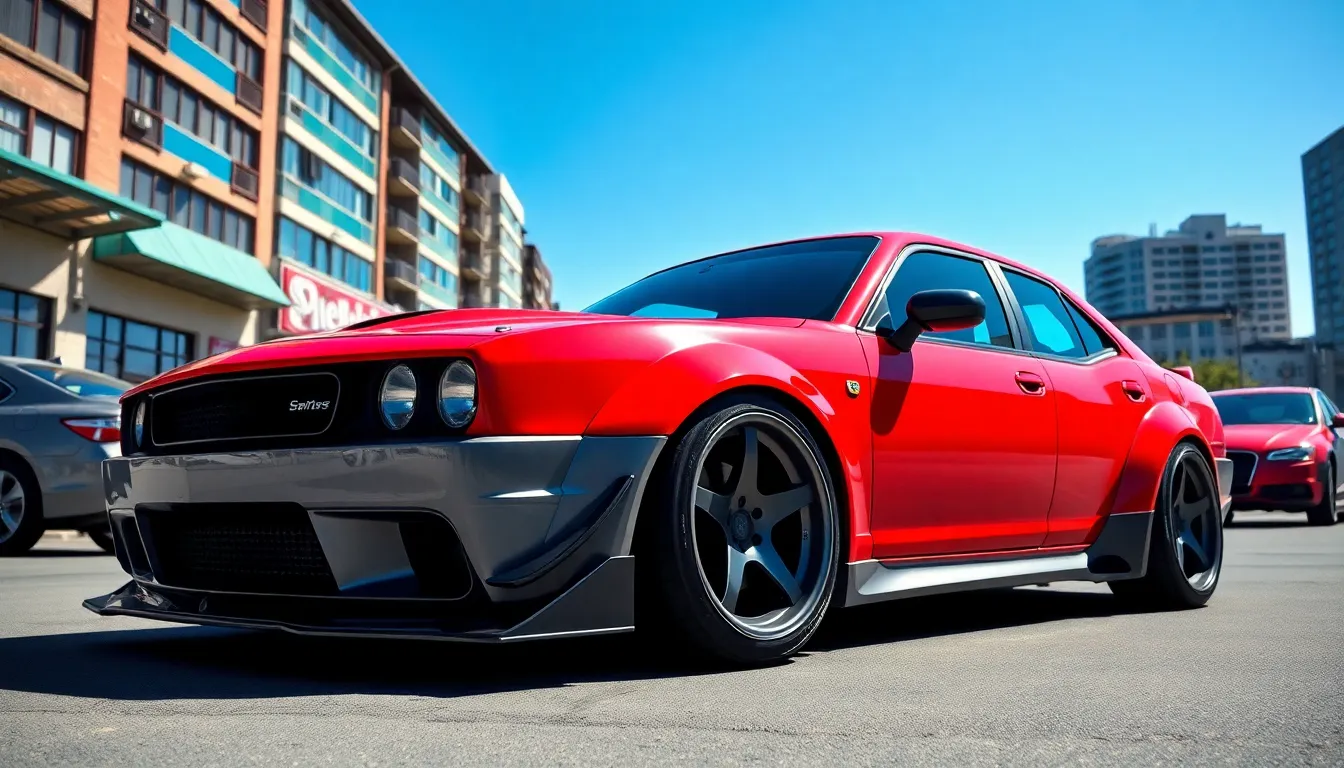
We need to understand that car modifications exist within a complex legal framework that varies by location and type of enhancement. Building modified cars requires careful attention to regulations that can significantly impact our vehicle’s street legality.
Emissions Compliance Requirements
Federal emissions standards dictate which modifications we can legally install on our vehicles. The Environmental Protection Agency (EPA) requires all modified cars to maintain their original emissions certification, meaning we cannot remove or tamper with catalytic converters, oxygen sensors, or emission control systems.
CARB compliance becomes essential for California residents and anyone planning to sell their vehicle in CARB states. The California Air Resources Board maintains stricter standards than federal requirements, requiring exact certifications for aftermarket parts like cold air intakes, exhaust systems, and engine management software.
Tampering penalties can reach $37,500 per violation for individuals and $75,000 for businesses that install non-compliant modifications. We must verify that performance modifications carry proper Executive Orders (EO numbers) to avoid these substantial fines.
Inspection requirements vary significantly between states, with some requiring annual emissions testing for modified vehicles. States like Texas, Georgia, and Illinois conduct strict inspections that can flag illegal modifications, potentially requiring expensive reversions to stock components.
Insurance and Registration Issues
Policy modifications become necessary when we install important upgrades to our vehicles. Insurance companies typically require notification of modifications exceeding $1,000 in value, and failure to disclose can result in claim denials or policy cancellations.
Agreed value coverage protects our investment in modified cars better than standard policies. This coverage type establishes a predetermined value for our vehicle, ensuring we receive appropriate compensation if our modified car suffers total loss or theft.
Registration complications arise when modifications significantly alter our vehicle’s appearance or specifications. Some states require re-inspection or updated registration documents when we install body kits, engine swaps, or suspension modifications that change ride height beyond specified limits.
Specialty insurance providers like Hagerty, Grundy, and American Collectors Insurance understand modified car values better than standard insurers. These companies often provide agreed value policies and coverage for track day activities that traditional insurers exclude.
State-Exact Modification Laws
California regulations set the standard for the most restrictive modification laws in the United States. The state prohibits modifications that increase noise levels above 95 decibels, requires exact certifications for performance parts, and maintains strict window tint limits at 70% visible light transmission for front windows.
Texas modification laws allow more flexibility, permitting louder exhaust systems and darker window tints (25% front, any darkness rear). But, the state requires annual inspections that check for proper emissions equipment and prohibits modifications that affect vehicle safety systems.
Florida regulations focus primarily on lighting and height restrictions, allowing important engine modifications while maintaining strict rules about headlight heights (24 to 54 inches) and bumper heights that vary by vehicle weight class.
New York requirements emphasize safety inspections that scrutinize suspension modifications, aftermarket lighting, and exhaust systems. The state requires annual inspections and maintains strict noise ordinances that can result in tickets for excessively loud modified cars.
| State | Exhaust Noise Limit | Window Tint Front | Height Restrictions | Annual Inspection |
|---|---|---|---|---|
| California | 95 dB | 70% | Stock +/- 3 inches | Emissions only |
| Texas | 95 dB | 25% | Varies by class | Safety & Emissions |
| Florida | 95 dB | 28% | 24-54 inch lights | Safety only |
| New York | 76 dB | 70% | Stock +/- 2 inches | Safety & Emissions |
Budget-Friendly Modifications for Modified Cars Beginners
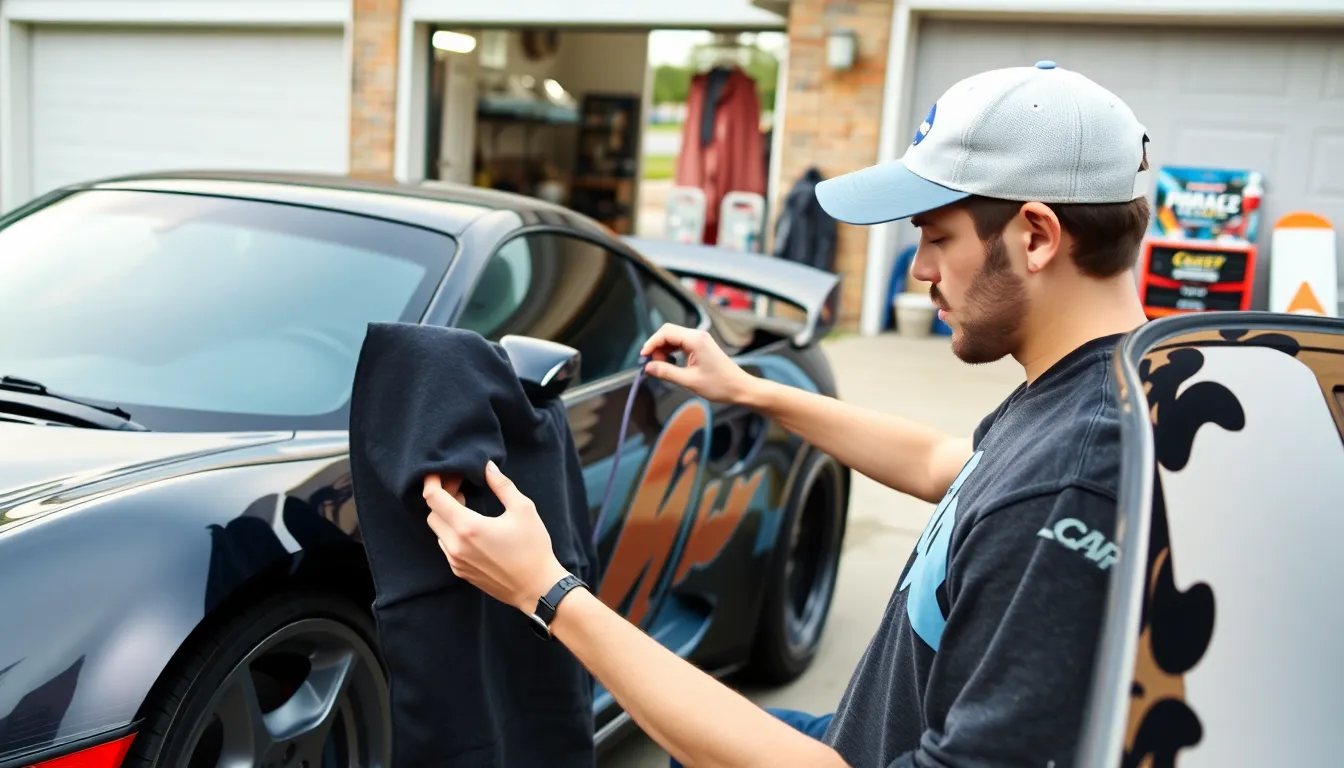
Starting your modified car journey doesn’t require a massive budget or professional installation. We’ve identified the most cost-effective modifications that deliver impressive results without very costly.
DIY Cosmetic Upgrades
Window tinting transforms your car’s appearance while providing practical benefits like UV protection and reduced interior temperatures. Quality tint film costs between $50-150 for a complete car, and installation requires only basic tools like a heat gun and squeegee. Professional installation typically runs $200-400, making DIY tinting a smart budget choice.
Vinyl decals and racing stripes create dramatic visual impact for under $100. We recommend starting with simple designs like hood stripes or side graphics that don’t require complex curves. High-quality automotive vinyl from brands like 3M or Avery Dennison ensures durability and professional appearance.
Plastidip coating offers reversible color changes for wheels, trim pieces, and emblems at roughly $20-30 per gallon. This rubberized coating provides matte finishes in various colors and easily peels off when you want to change styles. Multiple thin coats create better coverage and smoother finish than single heavy applications.
LED lighting upgrades modernize your modified car’s appearance for minimal cost. Interior LED kits range from $25-75 and dramatically improve cabin ambiance. Exterior underglow kits cost $50-150 and create show-stopping effects, though you’ll need to verify local legality before installation.
Affordable Performance Parts
Cold air intake systems represent the most accessible performance modification for beginners, typically costing $150-300. These systems increase airflow to your engine and often produce noticeable improvements in throttle response. Brands like K&N, AEM, and Injen offer direct-fit options that install with basic hand tools.
Performance air filters provide similar benefits to full intake systems at fraction of the cost. High-flow filters from K&N or AEM cost $30-60 and drop directly into your stock airbox. These washable filters improve airflow while maintaining filtration efficiency and often last the lifetime of your vehicle.
Cat-back exhaust systems deliver both performance gains and enhanced sound for $300-800. These bolt-on systems replace everything from the catalytic converter back and typically add 5-15 horsepower. Companies like Borla, Flowmaster, and Magnaflow offer options that balance performance with reasonable noise levels.
Short shifters reduce throw distance and improve shifting precision for manual transmission cars. Most aftermarket short shifters cost $100-250 and install with basic tools. We’ve found that brands like B&M and Hurst offer excellent options that dramatically improve the driving experience.
Used Parts and Salvage Yard Finds
Salvage yards offer genuine OEM parts at substantial savings compared to dealership prices. Performance oriented models like Civic Si, WRX, or Mustang GT often end up in yards with valuable components intact. We recommend calling ahead to check inventory and bringing basic tools for removal.
Online marketplaces like Facebook groups, forums, and eBay Motors connect you with enthusiasts selling quality used parts. Modified car communities often have dedicated buy/sell groups where members offer parts at fair prices. Always verify compatibility and condition before purchasing, and prioritize local pickup when possible.
Take-off parts from other builds provide excellent value for beginners entering the modified car scene. Many enthusiasts sell stock components when upgrading, offering parts in excellent condition at reduced prices. Suspension components, wheels, and intake systems frequently appear in these secondary markets.
Manufacturer overstock sometimes reaches discount retailers at important savings. End-of-line products or discontinued colors often sell for 40-60% off retail pricing. We suggest following parts suppliers on social media to stay informed about clearance events and special promotions.
Professional vs DIY Modifications for Modified Cars
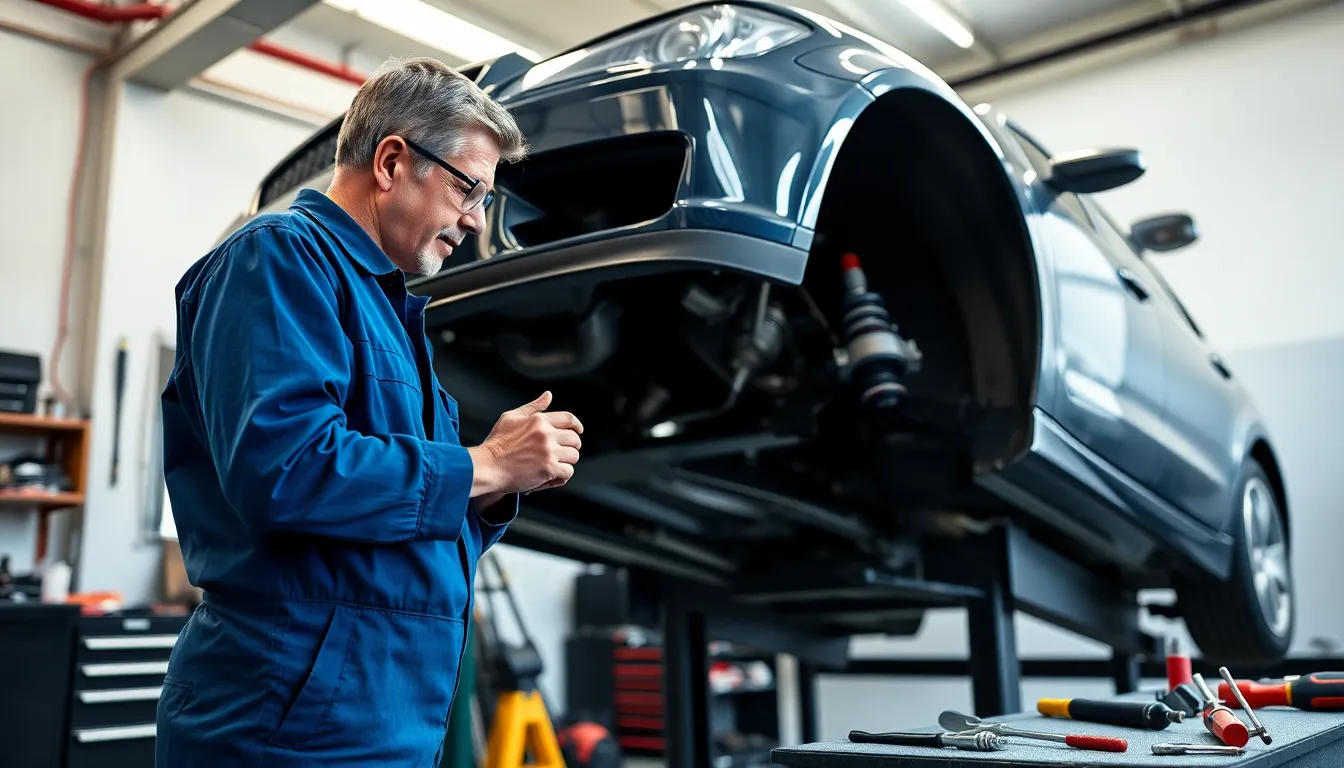
Choosing between professional installation and DIY work determines the success of your modified car projects. We’ll explore when each approach makes sense for different types of automotive modifications.
When to Hire Professionals
Engine tuning and ECU remapping require professional expertise due to their complexity and potential for catastrophic damage. Professional tuners use specialized dyno equipment worth $50,000 to $100,000 to safely calibrate fuel maps and ignition timing. Incorrect engine modifications can result in blown head gaskets, melted pistons, or complete engine failure costing $15,000 to $25,000 in repairs.
Roll cage installation and safety modifications demand certified fabricators who understand structural engineering principles. Professional welders certified in 4130 chromoly steel ensure proper joint penetration and stress distribution throughout the safety framework. Insurance companies often require professional installation documentation for coverage approval on safety equipment.
Complex electrical systems involving custom wiring harnesses, aftermarket ECUs, or advanced telemetry systems need experienced technicians. Professional installers prevent electrical fires through proper wire routing, fusing, and grounding techniques that DIY enthusiasts often overlook. Advanced diagnostic equipment costing $3,000 to $8,000 helps professionals troubleshoot intermittent electrical issues efficiently.
Suspension geometry modifications such as control arm replacement, coilover setup, or alignment adjustments require specialized tools and knowledge. Professional alignment racks cost $40,000 to $60,000 and provide precise measurements for camber, caster, and toe adjustments. Incorrect suspension setup leads to premature tire wear, handling problems, and potentially dangerous driving characteristics.
Essential Tools for DIY Projects
Socket sets and wrenches form the foundation of any DIY modification toolkit, with metric and standard sizes covering most automotive fasteners. Quality socket sets from brands like Snap-On or Mac Tools cost $800 to $1,500 but last decades with proper care. Torque wrenches ensure proper fastener tension, preventing overtightening that can strip threads or cause component failure.
Jack stands and floor jacks provide essential safety equipment for working under modified cars safely. Professional-grade aluminum floor jacks lift 3 tons while weighing 50% less than steel alternatives. Jack stands rated for 3 to 6 tons support the vehicle’s weight during extended work sessions, with safety locks preventing accidental collapse.
Diagnostic scan tools help DIY enthusiasts troubleshoot check engine lights and monitor performance parameters during modifications. OBD-II scanners range from $50 basic code readers to $2,000 professional-grade tools with live data streaming capabilities. Bluetooth-enabled scanners connect to smartphone apps for real-time monitoring of air-fuel ratios, ignition timing, and boost pressure.
Specialty tools for exact modifications include spring compressors for suspension work, brake bleeding kits for brake system maintenance, and panel removal tools for interior modifications. Spring compressors rent for $30 to $50 per day from auto parts stores, eliminating the need for expensive tool purchases. Panel removal tools prevent damage to plastic trim pieces during interior customization projects.
Cost Comparison Analysis
| Modification Type | DIY Cost | Professional Cost | Time Investment | Skill Level |
|---|---|---|---|---|
| Cold Air Intake | $200-400 | $400-600 | 2-3 hours | Beginner |
| Cat-Back Exhaust | $500-1,200 | $800-1,800 | 3-4 hours | Intermediate |
| Coilover Installation | $800-2,000 | $1,200-2,800 | 6-8 hours | Advanced |
| Turbo Installation | $3,000-6,000 | $5,000-12,000 | 20-30 hours | Expert |
| Roll Cage Fabrication | N/A | $2,500-8,000 | N/A | Professional Only |
Labor savings represent the primary financial advantage of DIY modifications, with professional shops charging $100 to $180 per hour for installation services. Simple modifications like air intake systems save $200 to $400 in labor costs while requiring only basic tools and 2 to 3 hours of work. Complex projects such as turbo installations save $2,000 to $6,000 in professional labor but require extensive mechanical knowledge and specialized tools.
Tool investment costs offset some DIY savings, especially for one-time projects requiring expensive specialty equipment. Professional-grade tools for suspension work cost $1,500 to $3,000 but become cost-effective when performing multiple modifications over time. Rental options for expensive tools like spring compressors or engine hoists reduce upfront costs for occasional DIY projects.
Risk assessment factors significantly impact the true cost comparison between DIY and professional installation. Mistakes during complex modifications can result in repair costs exceeding professional installation fees by 200% to 300%. Professional installations often include warranties covering parts and labor, providing financial protection against defective components or installation errors.
Common Mistakes to Avoid When Creating Modified Cars

Building modified cars requires careful planning and consideration to avoid costly pitfalls. We’ve identified the most critical errors that can derail modification projects and compromise both performance and safety.
Over-Modifying Without Purpose
We often see enthusiasts throwing modifications at their vehicles without establishing clear goals or understanding how components work together. Random bolt-on parts like oversized turbochargers paired with stock internals frequently result in catastrophic engine failures and wasted investments.
Comprehensive modification plans should address exact objectives such as improved quarter-mile times, enhanced cornering capabilities, or increased daily drivability. Engine modifications require supporting components like upgraded fuel systems, reinforced transmissions, and enhanced cooling systems to handle additional power output effectively.
We recommend establishing modification phases that build upon each other systematically. Stage 1 might include exhaust systems and cold air intakes, Stage 2 could incorporate turbocharger upgrades and engine management tuning, while Stage 3 would involve internal engine components and advanced fuel delivery systems.
Visual modifications should complement performance upgrades rather than overshadowing functional improvements. Wide body kits demand wider wheels and appropriate suspension geometry adjustments, while lowered suspension setups require careful consideration of approach angles and daily driving practicality.
Ignoring Reliability Concerns
We frequently encounter modified cars that sacrifice long-term durability for short-term performance gains, resulting in expensive rebuilds and constant maintenance issues. Aggressive engine tuning without proper supporting modifications leads to premature component wear and unexpected failures during critical driving situations.
Daily driven modified cars require different approaches compared to dedicated track vehicles or weekend cruisers. Street cars need conservative tuning parameters, quality aftermarket parts with proven reliability records, and regular maintenance schedules that account for increased stress on mechanical components.
Temperature management becomes critical when increasing power output beyond factory specifications. Modified engines generate excessive heat that stock cooling systems can’t handle effectively, leading to overheating conditions and potential engine damage during normal driving.
We always emphasize the importance of using quality components from reputable manufacturers rather than choosing the cheapest available options. Budget turbochargers, intercoolers, and fuel injectors often fail prematurely, creating dangerous driving conditions and requiring expensive emergency repairs.
Regular maintenance intervals should be shortened for heavily modified vehicles, with oil changes occurring every 3,000 miles instead of factory recommended intervals. Modified car owners must monitor fluid conditions, inspect components regularly, and address issues immediately before they escalate into major problems.
Skipping Professional Inspections
We’ve seen many modification projects that bypass professional evaluations, resulting in safety hazards and failed inspections when problems are eventually discovered. Complex modifications like roll cage installations, custom electrical systems, and engine swaps require expert verification to ensure proper execution and compliance with safety standards.
Professional dyno tuning provides accurate power measurements and identifies potential issues before they cause permanent damage to modified engines. Self-tuning attempts using generic maps frequently result in lean air-fuel ratios, excessive timing advance, and catastrophic engine failures that could have been prevented with proper professional oversight.
Alignment specifications change dramatically when installing lowered suspension components, upgraded springs, and performance tires on modified cars. Professional alignment services ensure proper geometry settings that maximize tire life, improve handling characteristics, and prevent premature suspension component wear.
We strongly recommend professional inspections after completing major modification phases, particularly when multiple systems have been altered simultaneously. Qualified technicians can identify interference issues, improper installations, and potential failure points that inexperienced builders might overlook during assembly.
Insurance inspections may be required when modifications significantly alter vehicle value or performance characteristics. Professional documentation of modification work helps establish proper coverage levels and protects against potential claim disputes following accidents or theft incidents.
Future Trends in Modified Cars Culture
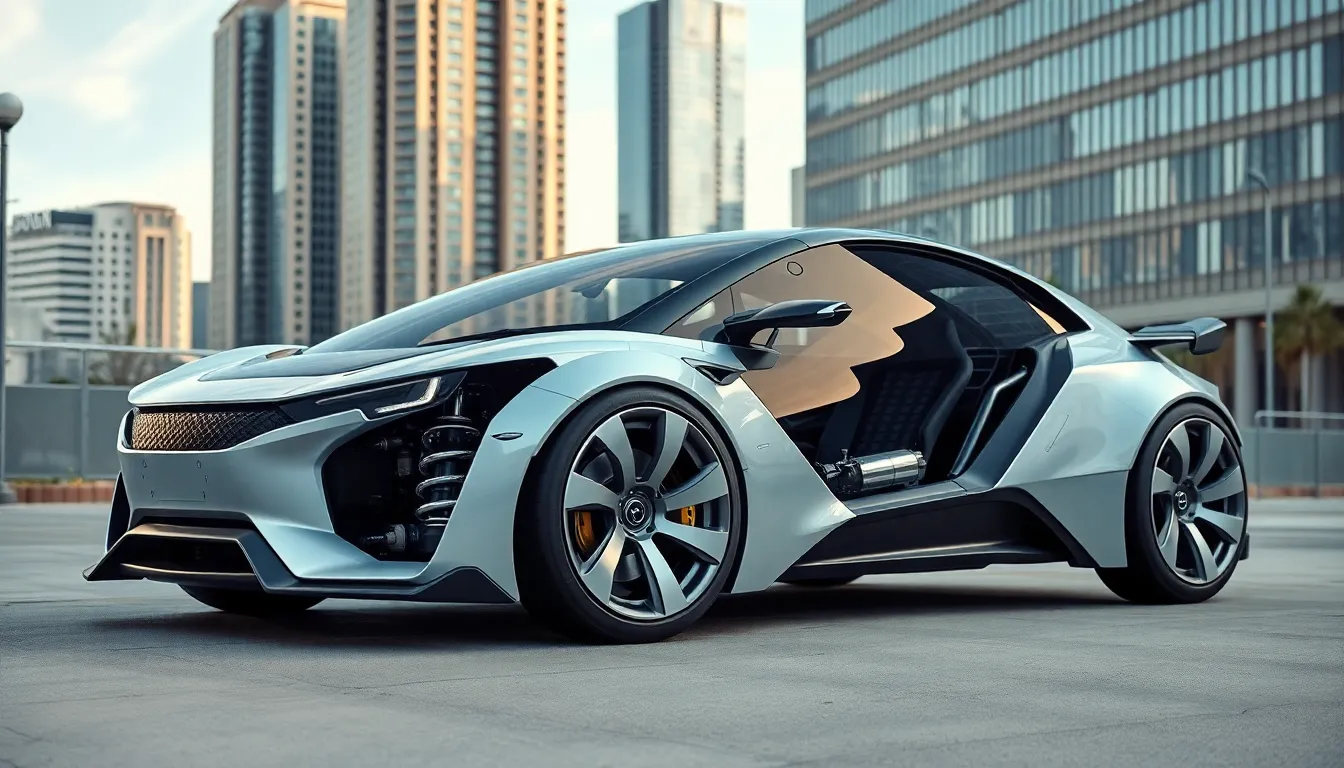
The automotive modification industry is evolving rapidly as technology advances and environmental consciousness shapes our industry. We’re witnessing revolutionary changes that will define the next generation of car customization.
Electric Vehicle Modifications
Electric vehicle modifications are transforming how we approach performance tuning and aesthetic customization. Battery pack upgrades represent the most important advancement, with aftermarket companies developing 100+ kWh battery systems that extend range beyond 400 miles on popular EV platforms like the Tesla Model S and Ford Mustang Mach-E.
Motor swaps in electric vehicles offer instant torque improvements, with dual motor conversions increasing horsepower from 300 to over 600 HP in vehicles like the Nissan Leaf and Chevy Bolt. Suspension modifications for EVs require specialized knowledge due to battery pack weight distribution, with companies like KW and Bilstein developing EV exact coilover systems.
Aerodynamic modifications take on new importance in electric builds, with custom air dams and rear diffusers improving efficiency by 8-12% in highway driving conditions. Regenerative braking system tuning allows enthusiasts to customize energy recovery rates, with aftermarket controllers providing three distinct modes: aggressive, balanced, and minimal regeneration.
Charging system modifications include installing Level 2 home chargers rated at 40-80 amps, while portable DC fast charging units enable track day participation without range anxiety. Weight reduction modifications focus on replacing heavy OEM components with carbon fiber alternatives, with hood replacements saving 15-20 pounds and full body panel conversions reducing total vehicle weight by 100+ pounds.
3D Printing Custom Parts
3D printing custom parts revolutionizes how we create unique modifications and replace discontinued components. Desktop FDM printers using PETG and ABS materials produce functional interior trim pieces, gauge bezels, and air vent covers that match OEM quality standards.
Resin printing enables creation of detailed emblems, badges, and decorative elements with surface finishes comparable to injection molded parts. Carbon fiber reinforced filaments allow production of structural components like intake manifold spacers, battery hold downs, and mounting brackets that withstand engine bay temperatures exceeding 200°F.
Prototype development through 3D printing reduces modification costs by 60-80% compared to traditional fabrication methods. Enthusiasts design custom shift knobs, steering wheel inserts, and center console organizers that perfectly fit their exact vehicle models and years.
Metal 3D printing services produce titanium exhaust tips, aluminum intake runners, and steel suspension components that meet automotive grade specifications. Digital part libraries enable sharing of modification files across global communities, with platforms like Thingiverse hosting thousands of automotive exact designs.
Reverse engineering discontinued parts becomes possible through 3D scanning technology, allowing reproduction of rare trim pieces, interior components, and even some mechanical parts for classic vehicle restoration projects.
Smart Technology Integration
Smart technology integration transforms modified cars into connected, data driven performance machines. OBD-II based performance monitors provide real time engine data through smartphone apps, displaying parameters like boost pressure, air/fuel ratios, and exhaust gas temperatures during driving sessions.
Dash cam systems with GPS tracking record lap times and driving routes, with cloud storage enabling automatic backup of footage and telemetry data. Remote start systems integrate with smartphone control, allowing engine warm up, climate control adjustment, and security system monitoring from distances up to 1 mile.
Performance data logging systems capture acceleration times, cornering G-forces, and braking distances with precision timing accurate to 0.01 seconds. Advanced ECU tuning platforms offer over the air updates, enabling remote tune adjustments and performance optimization without physical shop visits.
Smart suspension systems automatically adjust damping rates based on driving conditions, with magnetic ride control adaptations providing street comfort and track performance in the same setup. Tire pressure monitoring advances beyond basic alerts, providing individual wheel temperature monitoring and predictive maintenance scheduling.
Vehicle to vehicle communication systems enable modified car meets and convoy driving coordination, with real time location sharing and group messaging capabilities integrated into aftermarket head units.
Conclusion
The industry of modified cars continues to evolve with exciting possibilities for every enthusiast. We’ve explored everything from budget-friendly DIY upgrades to professional-grade performance enhancements that transform ordinary vehicles into extraordinary machines.
Whether you’re drawn to visual modifications that showcase your personal style or performance upgrades that unleash your car’s potential remember that successful customization requires careful planning and attention to legal requirements. The key lies in balancing your vision with practical considerations like safety reliability and compliance.
As electric vehicles and smart technology reshape the automotive industry we’re witnessing the birth of new modification opportunities. The future holds endless potential for creative expression and performance innovation in car culture.
Your modified car journey is unique to you. Take time to research plan carefully and enjoy the process of creating something truly special that reflects your passion for automotive excellence.
Frequently Asked Questions
What are the most popular cars for modifications?
The most popular modified cars include the Honda Civic, Subaru WRX STI, and Mazda MX-5 Miata. These vehicles are favored for their strong aftermarket support, tuning potential, and enthusiast community. The Civic is known for engine swaps and suspension upgrades, the WRX STI for rally-inspired modifications, and the MX-5 for track-focused handling improvements.
What are the essential performance modifications for beginners?
Three fundamental performance upgrades include engine tuning and ECU remapping for optimized power delivery, cold air intake systems for improved airflow and efficiency, and exhaust system upgrades for better flow and sound. These modifications provide noticeable performance gains while being relatively accessible to newcomers in car customization.
Are car modifications legal?
Car modification legality varies by state and local regulations. Key considerations include maintaining federal emissions compliance, meeting state inspection requirements, and adhering to specific modification laws. California has the most restrictive regulations, while states like Texas and Florida are more lenient. Always research local laws before modifying your vehicle.
How much do car modifications typically cost?
Modification costs vary widely depending on the type and complexity. Budget-friendly options like window tinting, vinyl decals, and performance air filters range from $50-$500. Mid-range modifications like cold air intakes and cat-back exhausts cost $200-$1,000. High-end modifications like engine swaps and custom paint jobs can exceed $10,000.
Should I do modifications myself or hire professionals?
Simple modifications like air filter replacements, vinyl applications, and basic cosmetic upgrades can be DIY projects. However, complex tasks like engine tuning, roll cage installation, electrical systems, and suspension work require professional expertise. Consider your skill level, available tools, and safety requirements when deciding.
What safety modifications should I consider?
Essential safety modifications include roll cages made from 4130 chromoly steel for structural protection, upgraded braking systems with big brake kits for improved stopping power, and fire suppression systems for catastrophic fire prevention. These modifications become increasingly important as you enhance your vehicle’s performance capabilities.
How do modifications affect car insurance?
Modifications can significantly impact insurance coverage and premiums. You must notify your insurance company about significant upgrades, as undisclosed modifications can void coverage. Some insurers offer specialized policies for modified vehicles, while others may increase rates or refuse coverage. Document all modifications and work with knowledgeable agents.
What are common mistakes to avoid when modifying cars?
Avoid over-modifying without clear goals, as this can lead to compatibility issues and wasted money. Don’t sacrifice reliability for performance gains, and ensure modifications work together systematically. Skipping professional inspections for complex work, using low-quality parts, and ignoring regular maintenance are costly mistakes that can compromise safety and performance.
Can electric vehicles be modified?
Yes, electric vehicle modifications are becoming increasingly popular. Common EV modifications include battery pack upgrades for extended range, motor swaps for increased performance, and specialized suspension modifications. The EV modification scene is rapidly evolving with new technologies and aftermarket support, representing the future of automotive customization.
What tools do I need for DIY car modifications?
Essential DIY tools include comprehensive socket sets, quality floor jacks and jack stands, torque wrenches for proper fastening, and basic diagnostic tools for troubleshooting. Additional tools like trim removal kits, multimeters, and specialized equipment depend on your specific modification projects. Invest in quality tools for safety and long-term use.

